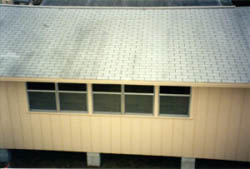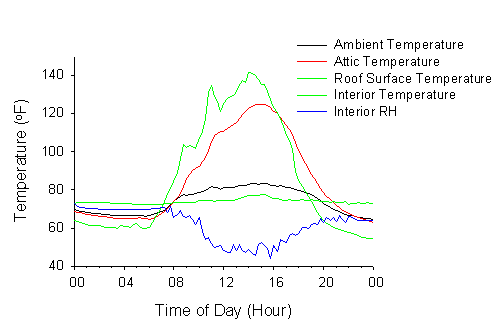
![]()
Roofs
 The A-frame roofs currently in place consist of gray asphalt shingles over
3/4 " plywood decking. One segment is 36' 3" x 11' 9" and
the other is 36' 3" x 15' 9". This longer half provides an overhang
for a handicap accessible entranceway on the South side. The replacement
roof is a reflective white metal roof. We decided to replace the roof
because previous research has shown that roof colors significantly impact
space cooling energy use (Givoni 1976). In fact, a white roof was shown to
reduce cooling loads by approximately 13,000 kWh per year (10%) at Our Savior's
School (Parker et al. 1996b). Asphalt shingles are known to have poor reflectivity.
The reflectivity of gray asphalt shingles is 22%, black asphalt shingles
is 5%, whereas the reflectivity of a white metal roof is a 67% (Anderson
et al. 1991, Parker et al. 1993). This reflective white roof can decrease
cooling requirements by an average of 20%. This reduces AC energy use by
between 2%-43% (average 19%) with the greatest savings in the shoulder months
of March (28%) and November (35%) (Parker et al. 1996b). Reflective roofs
have been shown to reduce electricity use by approximately 20% in residential
buildings (Parker et al. 1995).
The A-frame roofs currently in place consist of gray asphalt shingles over
3/4 " plywood decking. One segment is 36' 3" x 11' 9" and
the other is 36' 3" x 15' 9". This longer half provides an overhang
for a handicap accessible entranceway on the South side. The replacement
roof is a reflective white metal roof. We decided to replace the roof
because previous research has shown that roof colors significantly impact
space cooling energy use (Givoni 1976). In fact, a white roof was shown to
reduce cooling loads by approximately 13,000 kWh per year (10%) at Our Savior's
School (Parker et al. 1996b). Asphalt shingles are known to have poor reflectivity.
The reflectivity of gray asphalt shingles is 22%, black asphalt shingles
is 5%, whereas the reflectivity of a white metal roof is a 67% (Anderson
et al. 1991, Parker et al. 1993). This reflective white roof can decrease
cooling requirements by an average of 20%. This reduces AC energy use by
between 2%-43% (average 19%) with the greatest savings in the shoulder months
of March (28%) and November (35%) (Parker et al. 1996b). Reflective roofs
have been shown to reduce electricity use by approximately 20% in residential
buildings (Parker et al. 1995).

This graph shows the temperatures associated with portable 035. The roof gets extremely hot reaching temperatures topping 130o F over the course of the day. While the ambient temperature averages 73.8o F, both the attic air and roof surface temperatures are quite a bit higher (86.02o F and 86.83o F on average, respectively) and are much higher during the hottest part of the day. This is primarily due to solar absorptance of the roof. This, in turn, increases the interior temperatures even though the HVAC is continually running.
